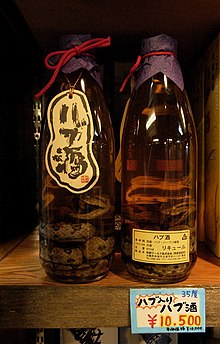Awamori
This article needs additional citations for verification. (October 2011) |


Awamori (泡盛) is an alcoholic beverage indigenous to and unique to Okinawa, Japan. It is made from long grain indica rice,[1] and is not a direct product of brewing (like sake) but of distillation (like shōchū). All Awamori made today is from indica rice imported from Thailand, the local production not being sufficient to meet domestic demand.
Awamori is typically 60–86 proof (30–43% alcohol), although "export" brands (including brands shipped to mainland Japan) are increasingly 50 proof (25% alcohol).[2] Some brands (notably hanazake) are 120 proof (60%) and are flammable. Awamori is aged in traditional clay pots to improve its flavor and mellowness.
The most popular way to drink Awamori is with water and ice.[3] When served in a restaurant in Okinawa, it will nearly always be accompanied by a container of ice and carafe of water. Awamori can also be drunk straight, on the rocks, and in cocktails. Traditionally, awamori was served in a kara-kara, a small earthen vessel with a small clay marble inside. The marble would make a distinctive "kara-kara" sound to let people know the vessel was empty, because it was considered rude to pour from an empty vessel for your drinking companions as Awamori was an expensive and treasured drink. These vessels are still found in Okinawa, but the clay marbles are often absent.
Another name for Awamori used in Okinawa is "island sake" (島酒, shima-zake), or shima for short.
In general the price of Awamori increases with the beverage's age.
Kōrēgusu is a type of hot sauce made of chillis infused in awamori and is a popular condiment to Okinawan dishes such as Okinawa soba.
History

Awamori owes its existence to Okinawa's trading history. It originates from the Thai drink Lao Khao.[4] The technique of distilling reached Okinawa from Thailand (formerly known as Siam Kingdom) in the 15th century. All Awamori is made from Thai rice ("thai-mai"). The Okinawans refined the distillation process, incorporating techniques from nearby countries, making it more suitable for the subtropical climate and incorporating the unique local black koji mold.[4] From the 15th to 19th century, Awamori was sent as a tribute to Okinawa's powerful neighbors, China and Japan.
Although Awamori is a distilled rice liquor, it differs from shochu in two ways: it uses Thai-style, long-grained Indica crushed rice rather than the short-grained Japonica usually used in shochu production; and instead of using white koji mold in fermentation (as in shochu production), black koji mold, indigenous to Okinawa, is used.
Before April 1983, Awamori was labelled as a second class shochu; it is now labelled as "authentic Awamori".
Kusu
When Awamori is aged for three years or more, it is called kusu (古酒, "old liquor"). This pronunciation is unique to Awamori and Okinawa; elsewhere in Japan, the word is pronounced "koshu" and refers to aged sake.[5] Legally, in order to earn the designation "kusu", over 50%, the Awamori must be aged for three years. In practice however, the remainder is usually six months old. If a specific age is noted, then all of the contents must be of at least that age. Awamori is aged underground in constant cool temperatures in clay pots or vases. Containers of Awamori can be found in the caves of Okinawa. Before the Battle of Okinawa during World War II, 200- and even 300-year-old kusu existed, but all were lost in the battle. Several attempts are being made to produce these kusu again.
Hanazake
On Yonaguni, Japan's westernmost island, the three distilleries of Donan, Yonaguni and Maifuna produce a variant of Awamori called hanazake (花酒), lit. "flower liquor", which has an alcohol content of 60%. Originally intended for religious ceremonies, hanazake is traditionally consumed straight.
Etymology
Awamori is thought to get its name from the bubbles awa (泡) that rise and swell mori (盛) during its distillation. The more bubbles, the higher the alcohol concentration in the final product.
Despite being commonly written with the kanji character 泡 (bubble), there are other theories on the origin of the name. One of these is that the name derives from 粟 (also pronounced awa), meaning millet, a raw material used to make Awamori centuries ago, now completely replaced with rice.
See also
Notes
- ^ Pellegrini, Christopher (July 22, 2014). The Shochu Handbook - An Introduction to Japan's Indigenous Distilled Drink. Telemachus Press. p. 21. ISBN 978-1940745282. Retrieved 23 November 2014.
- ^ http://kampai.us/shochu/shochu-reviews/awamori-scores
- ^ Pellegrini, Christopher (July 22, 2014). The Shochu Handbook - An Introduction to Japan's Indigenous Distilled Drink. Telemachus Press. p. 67. ISBN 978-1940745282. Retrieved 23 November 2014.
- ^ a b Nakasone, Ronald Y. (2002). Okinawan diaspora. University of Hawaii Press.
- ^ John Gauntner (2004). "Shochu & Awamori". Sake World. Archived from the original on 29 November 2010. Retrieved 2016-11-06.
{{cite web}}: Unknown parameter|deadurl=ignored (|url-status=suggested) (help)
References
- Okinawa Prefectural Government, "Awamori", Okinawa: Cultural Promotion Division, Okinawa Tourism and Cultural Affairs Bureau, 1996.
